► DBX takes on posh SUV rivals
► Where does the Aston sit…
► …between luxury and performance?
Big, heavy, luxurious and fast, Aston’s first SUV has some formidable rivals to face. We pit the performance benchmark, Lamborghini’s Urus, and the Bentley’s luxury yardstick, the facelifted Bentayga to see where Aston’s DBX sits.
Aston Martin DBX: pre-flight briefing
Why is it here?
Aston’s late arrival on the SUV bandwagon needs to be a hit if the company is to climb out of debt.
Any clever stuff?
The engine is from AMG, but everything else is new and bespoke, built around bonded aluminium architecture. Triple-chamber air springs are governed by a 48-volt anti-roll control system to quash any roly-poly body movements, while also allowing tiptoe off-roading height, easy-access loading mode and a low-slung sports setting for improved aero at speed.
Which version is this?
There is only one DBX. The price of this example has ballooned from £158k to £195,640 thanks to a heavily spanked options list, ranging from Hyper Red special paint (£3995) to an Aston Martin umbrella (£195).
Read our Aston Martin DBX review
An Aston for all seasons
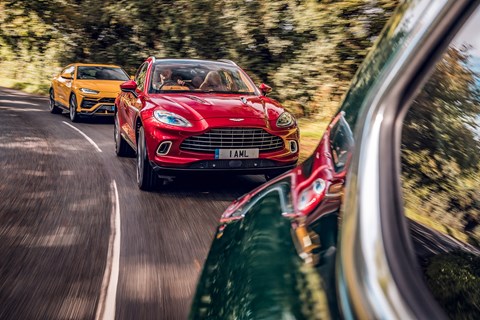
Above all else, this is an Aston Martin. If you’ve put 158 big ones down you surely care more than a little about driving, so you’ll be itching to prod the glowing starter button. The 542bhp twin-turbo 4.0-litre V8 wakes with a rumble, and the moment you set off you appreciate the absorbent ride quality and fluent steering. The DBX breathes down the road with a pliancy and flow the others cannot match. Aston’s chunky steering wheel design leaves much to be desired, but the feel it imparts is surprisingly delicate and accurate for such a large car.
The bandwidth of Aston’s SUV is perhaps its greatest achievement: in GT mode it’ll saunter and change up to an epically tall ninth gear, shutting down one bank of cylinders at a leisurely cruise, yet the AMG engine barks orders if you stab the throttle or slide into Sport or Sport+ mode, forcing the active exhaust baffles open. The rear-biased torque distribution can catch you out in the wet, especially on the performance-biased Pirelli P Zero tyres (we’d recommend the optional all-seasons rubber for daily UK use). It’s not quite as comfortable and quiet as the serene Bentley but the DBX’s Venn diagram spreads wide across relaxed Bentayga and athletic Urus qualities, even if it can’t match either extreme.
So yes, it’s very much an Aston Martin, and a very good one, but it also has to succeed against the long-established criteria of the premium SUV category – living the high life on four high-rise wheels. Aston has succumbed nearly two decades after Porsche first set the cat among the pigeons with the 2002 Cayenne. But where Zuffenhausen took a 911 blueprint and set the photocopier to 140%, Gaydon has come up with a fresh, more original design.
The DBX is clearly an Aston, especially seen from the front, but this is the most practical model ever to wear the winged badge. If earlier Rapides and Lagondas were born to transport executives in corporate style – and the bastard Cygnet to fulfil urban hopabout duties – the company’s first SUV is designed for everyday family life with children and dogs, bikes and skis in tow. It’s truly an Aston for all seasons and situations.
It’s a whisker over five metres in length, yet this is the best-looking SUV of our trio by a country mile, that elegant borderline Kamm tail shimmering in lustrous Hyper Red paintwork so ripe you may want to lick it. The fast tailgate angle masks a decent 632-litre boot that’s the widest here, with a flat floor and a spacesaver spare wheel nestling beneath; buttons in the boot raise or lower the air suspension to make it easier to lug luggage in or the dog out.
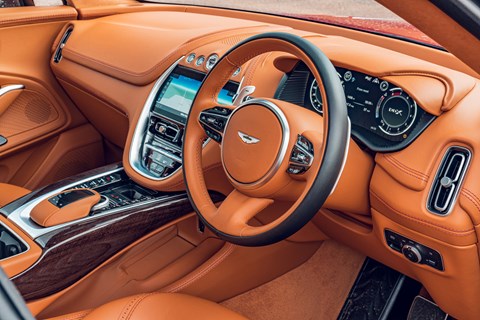
It seems strange to mark an Aston for practicality over performance, but this car’s purpose demands it. You enter via those beautiful-yet-fiddly pop-out slivers of aluminium that double as door handles and slide across non-existent sills straight into brilliantly quilted, supportive seats that never quite drop low enough. The cabin is upholstered extravagantly in wall-to-wall leather – ours so orange and bright it’s quite off-putting at first – and there’s no denying the opulence: broguing worthy of a Northampton shoe maker, leather pleats on the dashboard, and soft suede grab handles that wouldn’t look out of place in a boudoir.
The choice of materials might be indulgent (and we challenge you to find a better metal paddleshift), but a few ergonomic flaws let the side down. Taller drivers can’t see the top of the dials, while the glow of the instrument binnacle reflects annoyingly in the windscreen at night. The bootlid is curiously thick, making it easy to bang your head on the chunky latch, and the old-generation Mercedes Comand rotary controller is so close to the handrest that it’s tricky to operate. The infotainment itself is fundamentally okay and an improvement on what you’ll find in a DB11, but the lack of a touchscreen may be a hindrance to some.
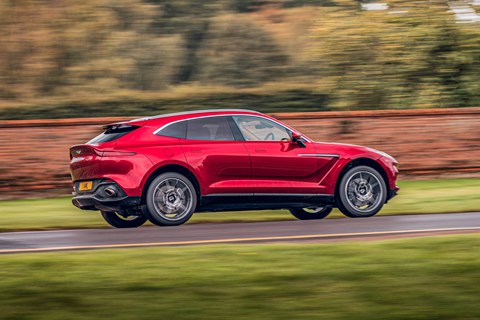
People bemoan the weight and stodginess of large SUVs, but the DBX shrinks around you. It’s a lot of fun, spiriting a 2.2-tonne 4×4 to 62mph in just 4.5sec, yet accompanied by excellent chassis poise and sector-
best rear headroom. The only concern is that our test car has to be repatriated after an electrical gremlin – and then the replacement has a rapid-flashing indicator as if a bulb had blown, yet all turn signals are behaving normally. Can you really afford such ‘bespoke concerns’ at this price? Or would a VW Group super-SUV be a safer bet?
Lamborghini Urus: pre-flight briefing
Why is it here?
The most extreme of them all: Lamborghini prides itself on offering the most focused product in any segment, so it should provide a stern test of the DBX’s sporting intent.
Any clever stuff?
It was, until recently, the fastest SUV in the world (the pre-facelift Bentayga Speed is 1km/h faster) storming to 62mph in 3.6sec and on to twice that in just 12.8sec.
Which version is this?
There is only the one version of the Urus on offer, here loaded up with 22-inch Nath rims (£3216), a carbonfibre interior trim package (£3675) and the upgraded, epic-sounding Bang & Olufsen audio system (£4375), including tweeters that rise up dramatically from the top of the dashboard. The Lamborghini’s the priciest car here: £172,411 basic, or £211,404 as tested.
Read our Lamborghini Urus review
Under that wild body: wildness
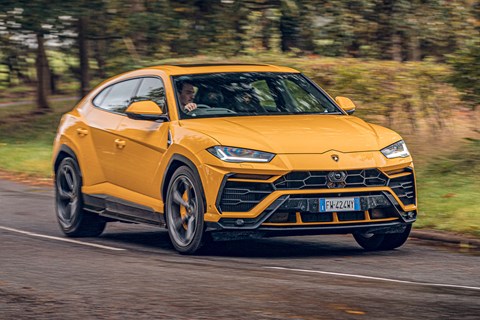
What a startling sight. Three years after its launch, the Lamborghini Urus is still a remarkable car in so many ways. Even without our test car’s many optional extras and its Giallo Auge paint, it’s quite unlike any other SUV you’ll ever clap eyes on. It makes try-hard SVRs, M-badged SUVs and hot AMGs look feeble by comparison, and the aggressive styling channels its inner LM002 with steely abandon.
But how much substance backs up the brutish looks? It is, after all, just another offspring of the mighty VW Group. No matter how much you wrap it up, the Urus is fundamentally based on the same MLB platform as the British Bentayga and German Cayenne before it’s sent to the Sant’Agata finishing school.
Is it really anything more than a gussied-up Audi Q7?
On this evidence, it very much is. The Rambo Lambo has an angular, sharply creased style all of its own, outside and in, where the obviously Audi-sourced haptic touchscreens are cleverly integrated into the centre console’s wall of carbonfibre and the cabin is peppered with enough Italian touches to feel distinctly different. Not necessarily better, but definitely different – and it’s all pleasingly well built.
Take the Anima and Ego driving mode selectors and gearlever: they’re striking and unusual – like a fighter jet’s throttles for selecting afterburners – but they’re actually a pain to use, making you cycle through every setting before you can go back to Strada once you realise that anything more sporting is excessive for pockmarked British roads. The tip-up missile-firing cover on the starter button is pure (primary school) theatre and the novelty quickly wears off, although your mates will giggle the first time they see it.
As with the Bentayga, questions arise over the digital dials; you sense that a department in Wolfsburg plays with graphics and fonts to make identical instrument displays more British, Italian or German, more luxurious or outrageous, to match the price point and marketing intent. Is today’s luxury transport really reduced to such hard-to-read aggressive typefaces in the name of product differentiation?
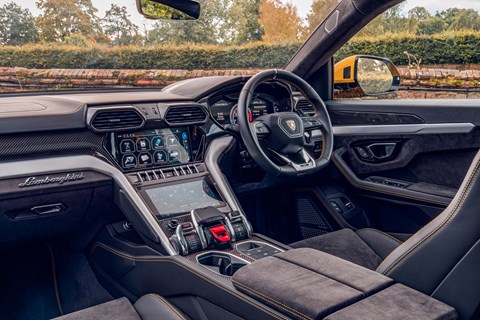
But we nitpick. This is a surprisingly practical and well-appointed cockpit and there’s plenty of space for family life – and when could we ever say that about a Lamborghini? The rear seats are supremely spacious, although that plunging roofline robs 5cm of headroom compared with the roomiest DBX. The Lambo’s boot is the narrowest here, but all three cars have practically shaped and sized loadbays that won’t disappoint, although the Urus is the only one with a small lip to carry bags over.
Climb in as the door shuts the final inches of its own accord, engage that missile-fire starter button and the Urus erupts with a howl. Considering the Bentayga and Urus share fundamentally the same 3996cc twin-turbocharged V8, you’ve got to marvel at the Italian tuning team’s poetic licence. The Urus develops an extra 99bhp for a rather ludicrous 160bhp-per-litre specific output and it feels every bit as fast as those numbers suggest, with a sharper response than either rival can muster.
The quoted 0-62mph time of 3.6sec is absurd for a 2.2-tonne SUV and it’s deeply impressive how easily the Lamborghini transfers that thrust to the road with unstickable traction. Special praise should go to the standard-fit ceramic brake discs that haul off speed with abandon, time and time again.
Thank a fruity Akrapovic exhaust for the aural histrionics and the sledgehammer 627lb ft torque mountain for the endless, horizon-reeling thrust. That’s a full 100lb ft over the already-fast DBX, and the pulling power is available from just 2250rpm. No wonder this car is so unrelentingly fast. It’s the most focused SUV of this trio and its ride is correspondingly the stiffest; not unacceptably so, but it patters and rarely settles, busier than either the smooth Aston or cushy Bentley.
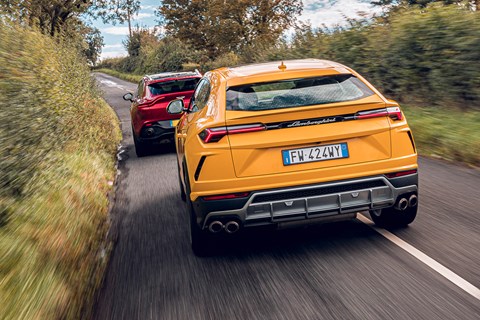
While some of the car’s fundamentals don’t disguise their blood relationship with the Audi RS Q8, once you start exploring the Urus’s extremes you realise just how different the Italian car is. Flick into Sport mode, never mind track-focused Corsa, and the exhaust note takes on a hard timbre, the percussion section promoted to the front of the orchestra pit, as the V8 pops and bangs extravagantly, the eight-speed automatic clinging to low gears. It’s all terrifically exciting in the playground, but more retiring types may feel a tad embarrassed.
Which kind of sums up the vibe of the Urus. All three of these cars are ridiculously fast and remarkably accomplished, yet the Urus feels akin to attaching running spikes to wellington boots, spawning some weirdly aggressive crossbreed. We love its barminess, but it cuts a rather absurd figure on the school run.
Bentley Bentayga V8: pre-flight briefing
Why is it here?
The Bentayga’s been refreshed just in time for the arrival of the DBX, which is aiming (among other things) to steal Bentley sales.
Any clever stuff?
There’s a nip ‘n’ tuck externally, but the biggest changes are inside, where there are new seats, the latest generation of infotainment, and wireless Apple CarPlay and Android Auto as standard.
Which version is this?
Ours is the V8 – the only model available for now (the Hybrid will follow, and some markets get the W12 Speed). Ours is Mulliner spec (22-inch alloys, quilted hide, metal fuel and oil caps), All Terrain pack (off-road-ready switchable suspension, boot rails) and Touring kit (adaptive cruise, night vision, head-up display…). The price is upped from £146,700 to £181,585…
Read our Bentley Bentayga review
The 180mph drawing room
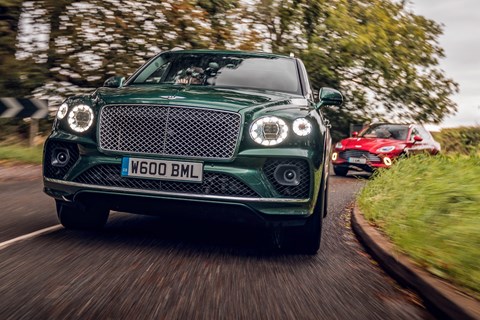
If the DBX is the new kid on the block, the Bentley has already become a familiar sight in Britain’s smarter postal districts. It can’t be coincidence that Crewe’s ushered along a facelift just in time to greet its new British rival. The Bentayga has always impressed and repelled in equal measure, with luxury overload, dynamic ability and family practicality in spades, but also an appearance that many find offputting.
The 2020 refresh brings a modest redesign, including Conti GT-style rear lights. Ours is resplendent in Verdant paintwork, a zingier, lighter British Racing Green, and it’s vast, easily the biggest car of this trio in every dimension. It feels it on the road, where you breathe in through tighter gaps and it bulges out of regular parking spaces. The upside? The Bentley has the deepest boot and a cabin so echoingly roomy that I’d challenge anyone not to get comfy in any seat (it’s the only car here with the option of a third row of pop-up seats, too).
You climb up into an exquisitely engineered cabin and there’s a reassuring heft to everything from the switchgear and traditional Bentley organ-stop air vents to the quality of leather and wood. Purists may decry the Audi fundamentals, yet most buyers will neither know nor care. Instead, marvel at the contactless phone charger, night vision, extraordinary Naim stereo, full-length, double-row smoked-glass sunroof and substantially improved infotainment system (though we’re less convinced by the overwrought virtual dials, digitally upgraded like the Lambo’s). We also can’t quite believe that they’ve snuck the fan speed selector into the touchscreen. Surely that’s not the kind of Blower that Bentley customers want?
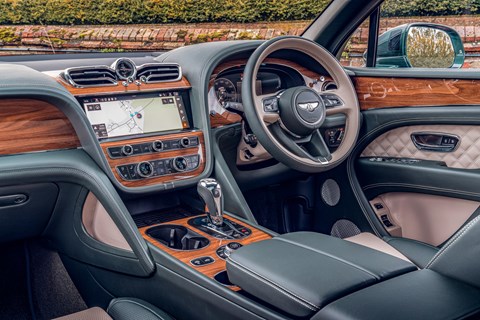
If family duties are a top buying requirement, the Bentayga makes a strong case for itself. Its 589-litre boot is huge and stretches further back than any rival, with no impediment to access and convenient buttons to lower the air springs (like on the Aston) and to conjure a pop-out towbar for lugging your pony/powerboat at the weekend. Our test car came equipped with a space-saver spare wheel and loadbay locking rails to hold luggage in place. It feels brilliantly engineered and tough; we’d be less worried about reliability here than in the unproven Aston.
Slide into those magnificent massaging, electro-everything seats, stab the start button and you’ll just about make out the distant V8 hum. The Bentley is markedly more refined than either of these rivals, its default mode providing a hushed cruise as it wafts along in eerie near-silence. Only in the lairier Sport mode at full throttle is the engine uncorked, a gentleman’s cough clearing the throat before a melodious V8 throb emerges when you rev it hard, but even then it’s significantly quieter than the DBX and, especially, the ostentatious Urus.
This calmness defines the Bentayga’s character. It’s demure, happiest at six-tenths or below, where you’ll lap up the plump ride, the eight-speed automatic transmission slurring through gearchanges with imperceptible polish, relaxed steering inputs nudging the prow. Just watch out for the wretched lane-keep assist system, which must be disabled to prevent the car constantly nibbling away at your inputs.
It’s hard to reconcile those enormous 22-inch wheels with the compliant ride quality; select Comfort and the Bentley floats over crests, yet there is little thud and it’s generally cosseting and quiet.
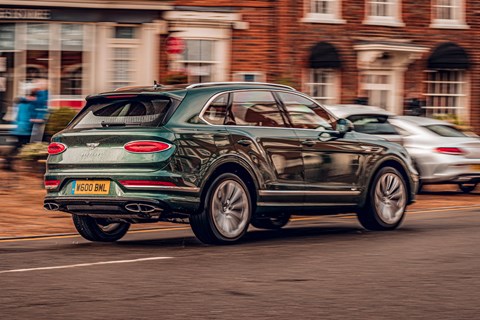
Turn up the wick, flick the car into all-rounder ‘Bentley’ mode (our preferred choice) or Sport, and it never quite shakes off the penalty of that extra bulk. The Bentayga is the porkiest car here at 2.4 tonnes and it feels every one of those killer-grammes, yet the 48-volt anti-roll system – versions are fitted to all three of these cars – works wonders to stop the body listing like a dilapidated country mansion if you hurl it into a corner, and you’ll never tire of the way it deploys all 568lb ft and 542bhp in a secure fashion.
Where the DBX broke traction surprisingly often, feeling as tail-happy as one of Aston’s sports cars, the Bentayga is more effective at transferring every single pony to the tarmac. Nail the throttle, the turbos spool up and it simply slingshots up the road on its way to 62mph in just 4.5sec. The brakes are reassuringly powerful when you drop anchor.
They’ve done a neat job updating the Bentayga. It marks its card as the sensible choice here: the one if you want relatively unobtrusive family transport with lashings of British charm and quality, yet the ability to get a wiggle on as you peg it down for a weekend at your Cornish getaway.
The final reckoning
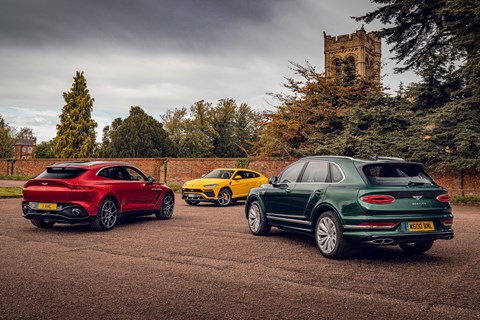
This is a rarefied breed of car – a genre of SUVs for those who have tired of a Range Rover and want a little more luxury, a degree more rarity and a sackload of extra performance to boot. You may decry the values these cars espouse (between them, they weigh nearly seven tonnes and cost over half a million quid), but to drive them is to be sucked down a rabbit hole and transported into a new world of lofty driving positions, extravagant luxury and the kind of light-speed acceleration that would make mincemeat of a Porsche 718.
Picking a winner is all about defining your intent. If you want the ultimate in performance, look no further than the Lamborghini, one of the world’s fastest and most extreme SUVs. It’s become the bestselling bull of all, and if you can live with its image it’ll do a very fine job indeed of playing family chariot by day and devilish cruise missile by night. It’s a surprisingly visceral experience once you’ve mastered the driving modes, yet you always feel it’s trying a little too hard to transpose some Aventador spirit into a huge hulking family 4×4. It’s an acquired taste.
The Bentley is the pick for those who want a safer option – an SUV that can do it all, but with a more restrained polish than the outré Lamborghini. This is a huge car, the most practical, and the quality of build and craftsmanship is staggering – with a proven reliability record and a decent turn of speed when required. It couldn’t be more different from the Urus, despite the fact the two cars share much DNA.
Which leaves the Aston Martin, the company’s first SUV in its 108-year history. It has a huge weight on its shoulders, and if successful might just be the car to rescue the company’s fortunes. This clean-sheet focus explains why the DBX aces it – they’ve gone and made an SUV that can do it all, from everyday family duties to thrilling on the long way home, and all wrapped up in a stylish, glamorous package. It delivers 90 per cent of the Lamborghini’s punch and 90 per cent of the Bentley’s comfort, striking a rare balance that lets it climb to the top of the pile. We’ll overlook the electrical gremlins on our test cars and declare it our favourite super-SUV of 2020. When you want this style, this versatility and this performance, and you have £150k to spend, DBX does indeed mark the sweet spot.
Check out more CAR comparison tests here